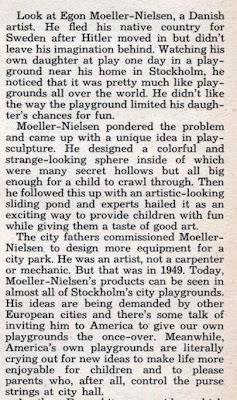I've been thinking for some time that it would be nice to have a place where my readers could talk about playspaces; whose format was more oriented to discussion than this blog--being more or less devoted to visual examples-- accomodates easily.
Off-blog, I get email with questions that I think would benefit from a wider group of respondents, and increasingly am contacted by students working on playground projects who would benefit from a place they could discuss their ideas.
So when I heard about the Better Project, it seemed to be a good solution.
I've started a 'make playgrounds better' project, and some topics to start us off. Since the premise of the site is improvement, they're worded as 'suggestions':
- Provide installation and maintenance instructions for natural playground elements
- Provide a place where anyone working on a playground project can collaborate
- Move from 'risk assessment' of playgrounds to 'risk-benefit analysis'
- Build a list of good plants for use on playgrounds
- Discuss the pros and cons of playground materials
After registering anyone can respond or start their own discussion within the 'make playgrounds better' project. So you can bring up any topic at any time, rather than just responding to my posts (though I hope you'll continue to do that as well!), and you can subscribe to the project's RSS feed to keep up. Feel free to continue to email me personally, but I hope the 'Make Playgrounds Better" project will accomodate more free-wheeling discussions and hopefully some group problem solving.
Best wishes and happy thoughts for long summer days on the playground,
arcady

















